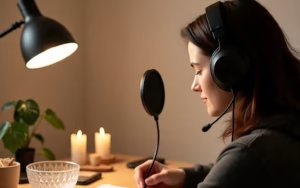ASMR, or Autonomous Sensory Meridian Response, videos have surged in popularity due to their calming effects and ability to help viewers relax, sleep, or focus. Whether you’re just starting out or looking to refine your skills, knowing how to properly edit ASMR videos is essential. Unlike fast-paced content, ASMR editing focuses on subtlety, sound quality, and immersive atmosphere. This guide will walk you through the essential steps of editing ASMR videos to achieve a professional and relaxing final product.
Prepare Your Raw Footage and Audio
Before jumping into editing, organize your raw materials. ASMR videos rely heavily on high-quality audio, so it’s common to use separate audio and video tracks. Make sure you record in a quiet environment and use high-fidelity microphones. Once you’re done filming, import both your audio and video files into your editing software (such as Adobe Premiere Pro, Final Cut Pro, DaVinci Resolve, or even free tools like HitFilm Express).
Sync Audio and Video
One of the first steps is syncing the high-quality audio with your video footage. Most ASMR creators use external recorders or microphones for better sound quality, so this step is crucial. Use visual cues (like clapping at the start of the recording) or audio waveforms to match the separate audio and video tracks perfectly.
Clean Up the Audio
Audio is the heart of ASMR, so take your time cleaning it. Use audio editing software like Audacity, Adobe Audition, or the built-in tools in your video editor to remove background noise, hums, or static. Use gentle noise reduction filters, and be careful not to over-process — you want the final sound to feel natural. Normalize volume levels to avoid harsh jumps in audio, and consider adding slight compression to even out the dynamic range.
Trim Unnecessary Parts
Cut out long pauses, mistakes, or off-camera noises to maintain a smooth and continuous experience. However, don’t rush through your cuts — ASMR viewers enjoy slow pacing. Keep transitions seamless to maintain the relaxing tone.
Add Subtle Effects and Transitions
Unlike other video genres, ASMR doesn’t need flashy transitions or effects. Keep things minimal and smooth. Crossfades or dissolves between cuts work well. Some creators add subtle video filters to soften the image or slightly desaturate colors for a calming effect. Be sure any visual adjustments don’t distract from the audio experience.
Incorporate Binaural Audio (Optional)
For a more immersive experience, you can experiment with binaural audio techniques. These involve simulating a 3D audio environment where sounds appear to come from different directions. Some video editors allow panning audio from left to right to simulate head movement or spatial cues, enhancing the ASMR effect.
Overlay Soft Background Music or Ambience (Optional)
Some ASMR videos benefit from very soft background music or ambient noise (like rain or a crackling fireplace). If you choose to add this, make sure it’s extremely subtle and doesn’t overpower the primary sounds. Keep it balanced so the listener’s focus remains on the intended triggers.
Export in High Quality
When exporting, choose a high-quality format that preserves both audio and video integrity. Common settings include 1080p resolution at 24–30fps with a high bitrate. For audio, consider exporting in 48kHz stereo to retain full depth. Use file formats like MP4 or MOV for wide compatibility.
Test the Final Product
Before publishing, watch and listen to your video in a quiet environment with headphones. This helps catch any unwanted noises or visual distractions you might have missed. Testing ensures that your viewers get the best possible sensory experience.




